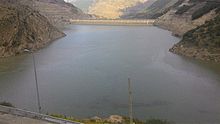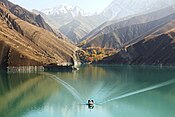Siah Bishe Pumped Storage Power Plant
| Siah Bishe Pumped Storage Power Plant | |
|---|---|
Francis pump-turbines | |
| Pumps | 4 x 235 MW (315,000 hp) MW reversible Francis pump-turbine (same as generating units) |
| Installed capacity | 1,040 MW (1,390,000 hp) |

The Siah Bisheh Pumped Storage Power Plant (
Background
A site was first identified for the power plant in the 1970s when a study was carried out on the water resources of the Albors Mountains by the Belgian firm Traksionel. Several sites for dams were identified including Siah Bisheh as a potential place for a pumped-storage power plant. In 1975, a feasibility report on the Siah Bisheh project was submitted to the Ministry of Energy. The Albors Mountains study concluded in 1977 and geologic studies began in 1978 but were halted in 1979 due to the Iranian Revolution. In 1983, Lahmeyer International was contracted to create designs for Phase II (underground excavation) which were completed in 1985, the same year construction on the dam's diversion tunnels began. Further designs for Phase I (superstructures) were developed and construction continued until 1992 when a lack of funding halted the project once again. Construction would not commence again until 2001. In 2002 and 2003, contracts for the dams and power plant were awarded and construction continued. The project was 90 percent complete as of April 2012.[4][5][6][7][8] Both the upper and lower reservoir were complete and had finished impounding in January 2013.[9] The first of four generators was commissioned in May 2013 and the remaining were operational by 1 September 2015.[3][10][11]
Design and operation
The power plant operates using a lower and upper reservoir along with a power plant connected to both. Water is either pumped from the lower to the upper reservoir to serve as stored energy or released from the upper to the lower reservoir to generate electricity. Pumping occurs during low demand, cheap electricity, periods such as night and generating will occur during peak demand, expensive electricity, hours such as during the day. The pumping/generating process repeats as needed.[4][7]
Both the upper and lower reservoirs are created by
Connecting the upper reservoir to the power station is an intake which feeds water into two 5.7 metres (19 ft) diameter head-race tunnels. Their length from the intake to two surge tanks (used to prevent water hammer) is 2,225 metres (7,300 ft) (left tunnel) and 2,185 metres (7,169 ft) (right tunnel). From the surge tanks the tunnels each turn into a 680 metres (2,230 ft) long penstocks which delivers water to the power station which is located underground near the lower reservoir. At the power station, each penstock bifurcates into two penstocks to supply the four Francis turbine pump-generators with water. The pump-generators have a generating capacity of 260 MW and pumping capacity of 235 MW. The generators can each discharge up to 65 cubic metres per second (2,300 cu ft/s) of water and the power is converted by transformers to 400 kV. After water is discharged by the generators, it proceeds down one of two tail-race tunnels (197 metres (646 ft) and 159 metres (522 ft) in length) before being discharged into the lower reservoir. When pumping is required, the pump-generators reverse into pumps and send water back to the upper reservoir through the same water conduits. Each generator can pump up to 50 m3/s (1,766 cu ft/s) of water.[5][13]
AF-Consult Switzerland Ltd acted as Owner's Engineer (Lead Consultant) during the design and supervision. Tractebel Engineering GmbH (Lahmeyer International) acted as Detailed Engineering Designer (EPC Engineer) for tunnels, shafts, manifolds, caverns and electro-mechanical equipment.
See also
External links
- Siahbishe Project at Iran Water & Power Resources Development Co.
References
- ISBN 978-3-642-14778-4.
- ^ a b "Siah Bishe Pumped Storage Project, Iran" (PDF). Colenco. Retrieved 17 February 2012.
- ^ a b "The first storage pump power plant of the country was put into operation in the presence of 1st Vice President Dr. Es'haq Jahangiri". Iran Water and Power Resources Development Co. 5 September 2015. Retrieved 16 December 2015.
- ^ a b c "Siahbishe Project". Iran Water & Power Resources Development Co. Retrieved 17 February 2012.
- ^ a b c "Siah Bishe Pumped Storage Plant". Lahmeyer International. Archived from the original on 14 June 2012. Retrieved 17 February 2012.
- ^ "Siah Bishe Pumped Storage Project Upper & Lower Dams" (PDF). Project Summary. Kayson. Archived from the original (PDF) on 19 January 2015. Retrieved 17 February 2012.
- ^ a b "Siah Bishe Pumped Storage Project — Iran" (PDF). Muetzenberg. Retrieved 17 February 2012.
- ^ "News: Iran's First Pump-Storage Project Exceeds 90%". Iran Water & Power Resources Development Co. Retrieved 19 April 2012.
- ^ "News: Impounding task of Siabisheh Upper and lower dams fulfilled". Iran Water and Power Resources Development Co. 22 January 2013. Retrieved 6 February 2013.
- ^ "News: Siabisheh Power Plant Connects to Power Network". Iran Water and Power Resources Development Co. Retrieved 15 May 2013.
- ^ "Iran moving toward clean energy with hydroelectric plant pumping only". Expansion. 14 January 2015. Retrieved 19 January 2015.
- ^ "Siahbise Project — Basic Information". Iran Water & Power Resources Development Co. Retrieved 17 February 2012.
- ^ a b "Siahbishe Project — Technical Info". Iran Water & Power Resources Development Co. Retrieved 17 February 2012.

